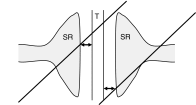Alterations in triad ultrastructure following repetitive stimulation and intracellular changes associated with exercise in amphibian skeletal muscle
- PMID: 17333488
- PMCID: PMC3714558
- DOI: 10.1007/s10974-007-9100-2
Alterations in triad ultrastructure following repetitive stimulation and intracellular changes associated with exercise in amphibian skeletal muscle
Abstract
This study used Rana temporaria sartorius muscles to examine the effect of fatiguing electrical stimulation on the gap between the T-tubular and sarcoplasmic reticular membranes (T-SR distance) and the T-tubule diameter and compared this with corresponding effects on resting fibres exposed to a range of extracellular conditions that each replicate one of the major changes associated with muscular activity: membrane depolarisation, isotonic volume increase, acidification and intracellular lactate accumulation. Following each treatment, muscles were immersed in isotonic fixative solution and processed for transmission electron microscopy (TEM). Mean T-SR distances were estimated from orthogonal intercepts to provide estimates of diffusion distances between T and SR membranes and T-tubule diameter was estimated by measuring its shortest axis in the sampled J-SR complexes. Measurements from muscles fatigued by low frequency intermittent stimulation showed significant (P << 0.05) reversible increases in both T-SR distance and T-tubule diameter from 15.97 +/- 0.37 nm to 20.15 +/- 0.56 nm and from 15.44 +/- 0.60 nm to 22.26 +/- 0.84 nm (n = 40, 30) respectively. Exposure to increasing concentrations of extracellular [K(+)] in the absence of Cl(-) to produce membrane depolarisation without accompanying cell swelling reduced T-SR distance and increased T-tubule diameter, whilst comparable increases in [K(+)](e) in the presence of Cl(-) suggested that isotonic cell swelling has the opposite effect. Acidification alone, produced by NH(4)Cl addition and withdrawal, also decreased T-SR distance and T-tubule diameter. A similar reduction in T-SR distance occurred following exposure to extracellular Na-lactate where such acidification was accompanied by elevations of intracellular lactate, but these conditions produced a significant swelling of T-tubules attributable to movement of lactate from the cell into the T-tubules. This study thus confirms previous reports of significant increases in T-SR distance and T-tubule diameter following stimulation. However, of membrane depolarisation, isotonic cell swelling, intracellular acidification and lactate accumulation, only isotonic cell swelling increases T-SR distance whilst membrane depolarisation and intracellular lactate likely contribute to the observed increases in T-tubule diameter.
Figures





Similar articles
-
The effect of extracellular tonicity on the anatomy of triad complexes in amphibian skeletal muscle.J Muscle Res Cell Motil. 2003;24(7):407-15. doi: 10.1023/a:1027356410698. J Muscle Res Cell Motil. 2003. PMID: 14677643
-
The effect of intracellular acidification on the relationship between cell volume and membrane potential in amphibian skeletal muscle.J Physiol. 2005 Mar 15;563(Pt 3):745-64. doi: 10.1113/jphysiol.2004.079657. Epub 2004 Dec 23. J Physiol. 2005. PMID: 15618273 Free PMC article.
-
Ultrastructural changes accompanying development of fatigue in frog twitch skeletal muscle fibres.Endocr Regul. 2005 Jun;39(2):43-52. Endocr Regul. 2005. PMID: 16229154
-
Effect of intracellular and extracellular ion changes on E-C coupling and skeletal muscle fatigue.Acta Physiol Scand. 1996 Mar;156(3):169-81. doi: 10.1046/j.1365-201X.1996.191000.x. Acta Physiol Scand. 1996. PMID: 8729677 Review.
-
The pH dependence of the contractile response of fatigued skeletal muscle.Can J Physiol Pharmacol. 1987 Apr;65(4):648-58. doi: 10.1139/y87-108. Can J Physiol Pharmacol. 1987. PMID: 3038287 Review.
Cited by
-
Elevation of extracellular osmolarity improves signs of myotonia congenita in vitro: a preclinical animal study.J Physiol. 2019 Jan;597(1):225-235. doi: 10.1113/JP276528. Epub 2018 Nov 20. J Physiol. 2019. PMID: 30284249 Free PMC article.
-
Sarcoplasmic reticular Ca2+-ATPase inhibition paradoxically upregulates murine skeletal muscle Nav1.4 function.Sci Rep. 2021 Feb 2;11(1):2846. doi: 10.1038/s41598-021-82493-w. Sci Rep. 2021. PMID: 33531589 Free PMC article.
-
Nernst-Planck-Gaussian finite element modelling of Ca2+ electrodiffusion in amphibian striated muscle transverse tubule-sarcoplasmic reticular triadic junctional domains.Front Physiol. 2024 Dec 5;15:1468333. doi: 10.3389/fphys.2024.1468333. eCollection 2024. Front Physiol. 2024. PMID: 39703671 Free PMC article.
-
Reciprocal dihydropyridine and ryanodine receptor interactions in skeletal muscle activation.J Muscle Res Cell Motil. 2011 Nov;32(3):171-202. doi: 10.1007/s10974-011-9262-9. Epub 2011 Oct 13. J Muscle Res Cell Motil. 2011. PMID: 21993921 Review.
-
Local calcium signals induced by hyper-osmotic stress in mammalian skeletal muscle cells.J Muscle Res Cell Motil. 2009;30(3-4):97-109. doi: 10.1007/s10974-009-9179-8. Epub 2009 May 13. J Muscle Res Cell Motil. 2009. PMID: 19437123
References
Publication types
MeSH terms
Substances
Grants and funding
LinkOut - more resources
Full Text Sources
Research Materials
Miscellaneous

